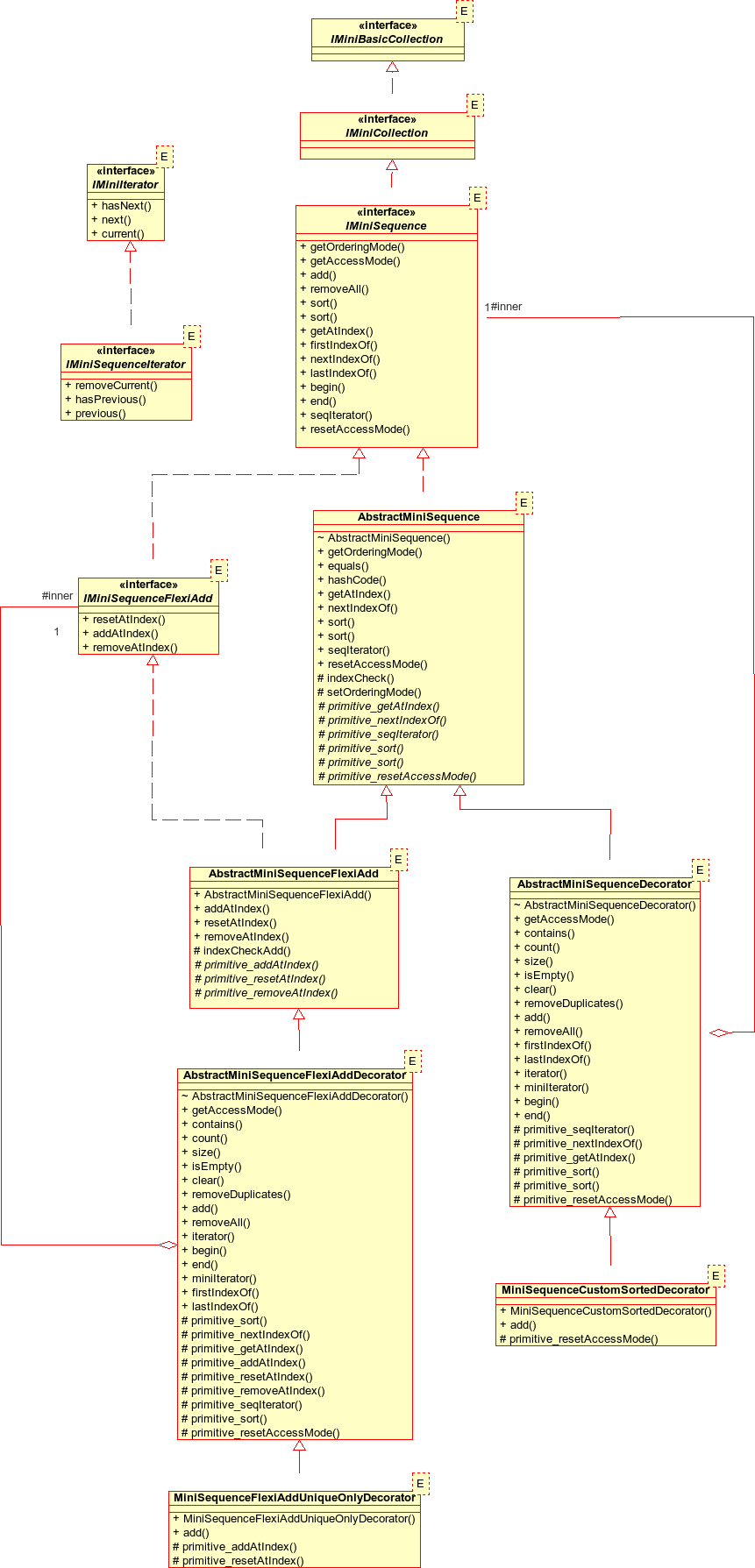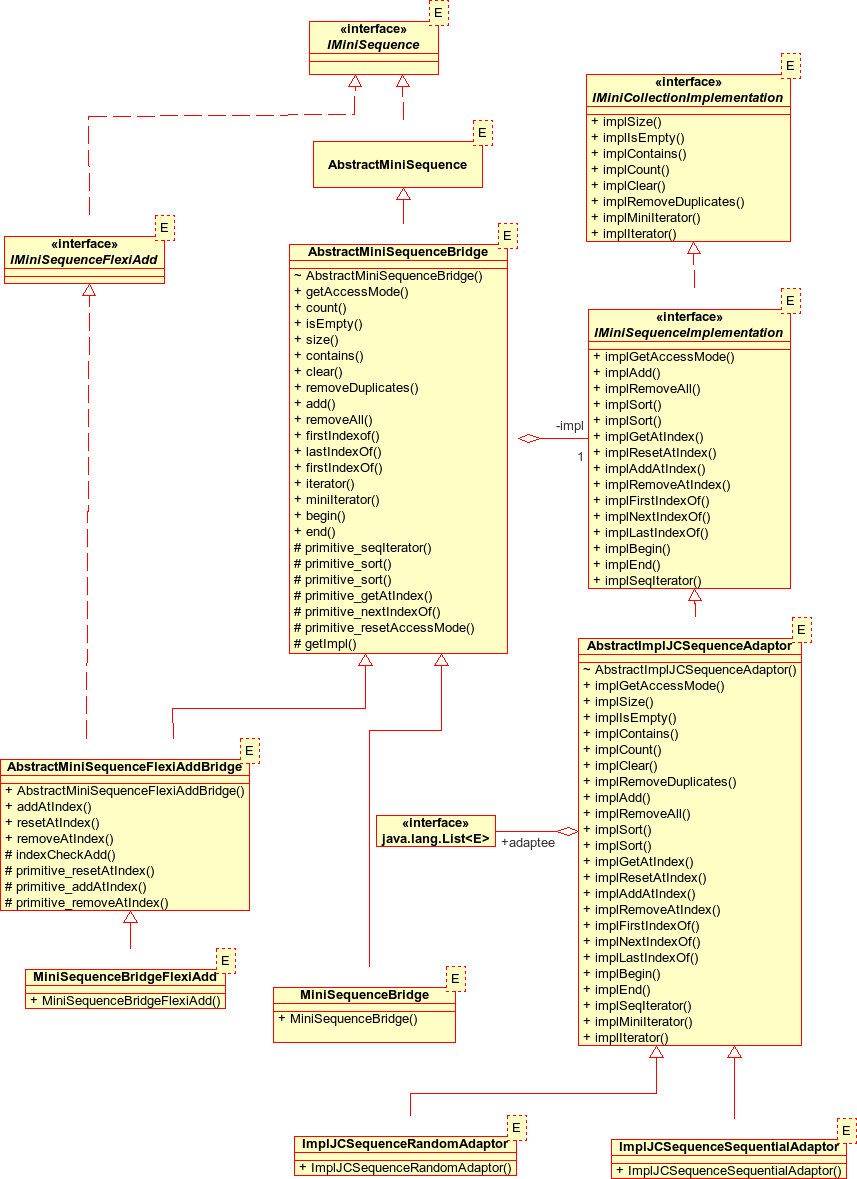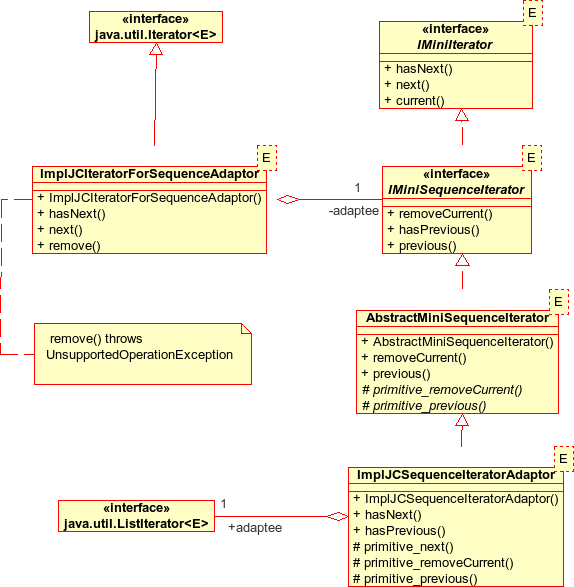User:Jenny Harlow/Design study/Final design detail
Contents |
Sequences
I do not discuss the design patterns used here in detail because these have already been covered in the initial design detail.
Main types and classes
After adding the IMiniSequenceFlexiAdd type that allows addition, resetting and removal at specified index positions, and other improvements discussed in relation to the initial design, the design for sequences looks like this:
IMiniSequence has an operation to reset the access mode (random access or sequential) which will presumably be ultimately implemented by changing from one underlying container to another: this is facilitated in my design by the use of bridges.
AbstractMiniSequenceDecorator composes an IMiniSequence and is used in this design to provide the sorted sequences. Factories take responsibility for type checking and other details for naturally sorted sequences so we only need one concrete MiniSequenceCustomSortedDecorator and this adds sorting on add() and on a change in access mode (in case that causes a change in the order of the sequence)
The decorator adding unique-elements-only wraps an IMiniSequenceFlexiAdd type. IMiniSequenceFlexiAdd is a subtype of IMiniSequence. We can therefore use a factory to provide a uniques-only IMiniSequence (composing an IMiniSequence and returning an IMiniSequence type), as well being able to make uniques-only IMiniSequenceFlexiAdd sequences using this decorator. Using factories we can spare clients hopeless attempts to instantiate make a type which is a subtype of the wrapped type.
One problem I did encounter here was how to arrange the inheritance for the AbstractMiniSequenceFlexiAddDecorator. Ideally, I would not have had to replicate the operations in common with AbstractMiniSequenceDecorator, but I could not have AbstractMiniSequenceFlexiAddDecorator extending both AbstractMiniSequenceDecorator and AbstractMiniSequenceFlexiAdd. I thought about composing an AbstractMiniSequenceDecorator but as well as being complicated, this would either mean two copies of the composed sequence or AbstractMiniSequenceDecorator allowing AbstractMiniSequenceFlexiAddDecorator access to its inner sequence which was horrible. So I ended up by replicating the decorator operations. There is probably a nicer way to do this but I am not sure what it is.
Bridges and implementations
The final bridge and implementation design is shown below.
The addition of the IMiniSequenceFlexiAdd type did cause many problems for the bridges and implementations because I did not change the specification of the IMiniSequenceImplementation type: any implementation has to be able to provide an implementation for addAtIndex, resetAtIndex and removeAtIndex. The AbstractMiniSequenceBridge uses what it needs and is extended by AbstractMiniSequenceFlexiAddBridge which uses the remaining operations through a protected getter for the implementation (getImpl()). This worked for my small design and concrete implementations using adaptors of the Java List interface, but it does restrict what can be used as an implementation and means that AbstractMiniSequenceBridge is not using all the operations of its implementation. I am not very happy with this aspect of the design - I suspect that I was just tired of it by the time I got it working and did not want to have to think about it any more.
Iteration
The IMiniSequenceIterator can remove the currently-pointed to element in the sequence and go backwards as well as forwards: other than the transfer of removeCurrent() from IMiniterator to the subtypes, the sequence iterator is essentially the same as in the initial design. For my sequence implementations I use adaptations of the Java ListIterator. I added an adaptation of my iterator back into the Java Iterator interface so that I could use the for-each construct. This was not strictly necessary for sequences - I could have just provided the Iterator on the adapted List, but I also wanted to nobble the Java Iterator remove() operation. I did this by taking shameless advantage of fact that Java marked remove() as 'optional'. I think that this is justified because implementing Iterable is not really part of the design, it is just to be able to show that we can use a for-each construct with the MiniCollection collections.


